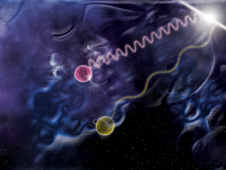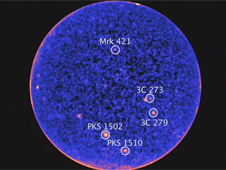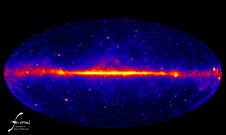Imagine the Universe News - 28 October 2009
Fermi Telescope Caps Its First Year With A Glimpse of Space-Time
| 28 October 2009 |
During its first year of operations, NASA's Fermi Gamma Ray Space Telescope mapped the extreme sky with unprecedented resolution and sensitivity. It captured more than one thousand discrete celestial sources which emit gamma rays -- the highest-energy form of light. Capping these achievements was a measurement that provided rare experimental evidence about the very structure of space and time.
"Physicists would like to replace Einstein's vision of gravity -- as expressed in his relativity theories -- with something that handles all fundamental forces," said Peter Michelson, principal investigator of Fermi's Large Area Telescope, or LAT, at Stanford University in Palo Alto, Calif. "There are many ideas, but few ways to test them."
Many approaches to new theories of gravity picture space-time as having a shifting, frothy structure trillions of times smaller than an electron. Some models predict that the foamy aspect of space-time will cause higher-energy gamma rays to move slightly more slowly than photons at lower energy. (This animation link shows the delay scientists had expected to observe.)
Such a model would violate Einstein's edict that all electromagnetic radiation -- radio waves, infrared, visible light, X-rays and gamma rays -- travels through a vacuum at the same speed.
On May 10, 2009, Fermi and other satellites detected a so-called short gamma ray burst, designated GRB 090510. Astronomers think this type of explosion happens when neutron stars collide. Ground-based studies show this event took place in a galaxy 7.3 billion light-years away. Of the many gamma ray photons Fermi's LAT detected from the 2.1-second burst, two possessed energies differing by a million times. Yet after traveling some seven billion years, the pair arrived just nine-tenths of a second apart.
"This measurement eliminates any approach to a new theory of gravity that predicts a strong energy dependent change in the speed of light," Michelson said. "To one part in 100 million billion, these two photons traveled at the same speed. Einstein still rules."
More Gamma-Ray Bursts
Fermi's secondary instrument, the Gamma Ray Burst Monitor, has observed low-energy gamma rays from more than 250 bursts. The LAT observed 12 of these bursts at higher energy, revealing three record setting blasts.
Among the gamma-ray burst standouts was GRB 090510, which displayed the fastest observed motions, with ejected matter moving at 99.99995 percent of light speed. The highest energy gamma ray yet seen from a burst -- 33.4 billion electron volts or about 13 billion times the energy of visible light -- came from September's GRB 090902B. Last year's GRB 080916C produced the greatest total energy, equivalent to 9,000 typical supernovae.
A New Picture of the Gamma-ray Sky
Scanning the entire sky every three hours, the LAT is giving Fermi scientists an increasingly detailed look at the extreme universe. "We've discovered more than a thousand persistent gamma ray sources -- five times the number previously known," said project scientist Julie McEnery at NASA's Goddard Space Flight Center in Greenbelt, Md. "And we've associated nearly half of them with objects known at other wavelengths."
Blazars -- distant galaxies whose massive black holes emit fast-moving jets of matter toward us -- are by far the most prevalent source, now numbering more than 500. In our own galaxy, gamma ray sources include 46 pulsars and two binary systems where a neutron star rapidly orbits a hot, young star.
"The Fermi team did a great job commissioning the spacecraft and starting its science observations," said Jon Morse, Astrophysics Division director at NASA Headquarters in Washington. "And now Fermi is more than fulfilling its unique scientific promise for making novel, high-impact discoveries about the extreme universe and the fabric of space-time."
NASA's Fermi Gamma Ray Space Telescope is an astrophysics and particle physics partnership, developed in collaboration with the U.S. Department of Energy, along with important contributions from academic institutions and partners in France, Germany, Italy, Japan, Sweden and the United States.




